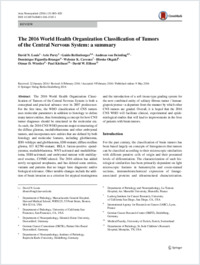The 2016 World Health Organization Classification of Tumors of the Central Nervous System: a summary.
- Louis DN Department of Pathology, Massachusetts General Hospital, Harvard Medical School, WRN225, 55 Fruit Street, Boston, MA, 02114, USA. dlouis@mgh.harvard.edu.
- Perry A Department of Pathology, University of California San Francisco, San Francisco, CA, USA.
- Reifenberger G Department of Neuropathology, Heinrich Heine University, Duesseldorf, Germany.
- von Deimling A German Cancer Consortium (DKTK), Partner Site Essen/Duesseldorf, Germany.
- Figarella-Branger D Department of Pathology and Neuropathology, La Timone Hospital, Aix Marseille University, Marseille, France.
- Cavenee WK Ludwig Institute for Cancer Research, University of California San Diego, San Diego, CA, USA.
- Ohgaki H International Agency for Research on Cancer (IARC), Lyon, France.
- Wiestler OD German Cancer Research Center (DKFZ), Heidelberg, Germany.
- Kleihues P Medical Faculty, University of Zurich, Zurich, Switzerland.
- Ellison DW Department of Pathology, St. Jude Children's Research Hospital, Memphis, TN, USA.
- 2016-05-10
Published in:
- Acta neuropathologica. - 2016
Animals
Brain
Central Nervous System
Central Nervous System Neoplasms
Glioma
Humans
Meningioma
World Health Organization
English
The 2016 World Health Organization Classification of Tumors of the Central Nervous System is both a conceptual and practical advance over its 2007 predecessor. For the first time, the WHO classification of CNS tumors uses molecular parameters in addition to histology to define many tumor entities, thus formulating a concept for how CNS tumor diagnoses should be structured in the molecular era. As such, the 2016 CNS WHO presents major restructuring of the diffuse gliomas, medulloblastomas and other embryonal tumors, and incorporates new entities that are defined by both histology and molecular features, including glioblastoma, IDH-wildtype and glioblastoma, IDH-mutant; diffuse midline glioma, H3 K27M-mutant; RELA fusion-positive ependymoma; medulloblastoma, WNT-activated and medulloblastoma, SHH-activated; and embryonal tumour with multilayered rosettes, C19MC-altered. The 2016 edition has added newly recognized neoplasms, and has deleted some entities, variants and patterns that no longer have diagnostic and/or biological relevance. Other notable changes include the addition of brain invasion as a criterion for atypical meningioma and the introduction of a soft tissue-type grading system for the now combined entity of solitary fibrous tumor / hemangiopericytoma-a departure from the manner by which other CNS tumors are graded. Overall, it is hoped that the 2016 CNS WHO will facilitate clinical, experimental and epidemiological studies that will lead to improvements in the lives of patients with brain tumors.
- Language
-
- English
- Open access status
- bronze
- Identifiers
-
- DOI 10.1007/s00401-016-1545-1
- PMID 27157931
- Persistent URL
- https://folia.unifr.ch/global/documents/287418
Statistics
Document views: 33
File downloads:
- fulltext.pdf: 0
